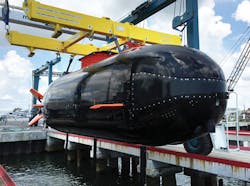Lockheed Martin to develop Special Ops mini-sub based on commercial technologies
MacDILL AIR FORCE BASE, Fla. - Undersea warfare experts at Lockheed Martin are making another run at designing an affordable mini-submarine to transport Special Operations combat swimmers covertly while minimizing swim time to keep the divers from becoming too exhausted to carry out their missions.
Officials of the U.S. Special Operations Command (SOCOM) at MacDill Air Force Base, Fla., announced a $166 million contract to the Lockheed Martin Mission Systems and Training segment in Riviera Beach, Fla., for the Dry Combat Submersible (DCS) program. Lockheed Martin experts will design, build, test, and maintain a dry-environment diver lock-in/lock-out undersea-mobility capability by designing and procuring commercially classed submersibles for use by Special Forces in special operations environments.
The contract is necessary to fill a capability gap for surface-launched dry submersibles for use in harsh maritime environments. Lockheed Martin will capitalize on commercially available submersible technologies and international classing safety certification to keep costs down.
This project represents SOCOM's latest attempt at the expensive, time-consuming job of developing mini-submarines to transport Special Forces warfighters covertly underwater to operational areas.
SOCOM officials have been planning a submersible combat swimmer delivery system since cancelling the Joint Multi-Mission Submersibles program in 2010 because it was too expensive.
In April 2012, SOCOM awarded a contract to Lockheed Martin to prototype a medium-sized DCS undersea vehicle. Later that year, SOCOM awarded a potential $44.3 million contract to submarine maker General Dynamics Electric Boat in Groton, Conn., to prototype a lightweight DCS mini-submarine to deliver combat swimmers.
The medium-sized DCS was to be about 38 feet long with high endurance and high passenger and cargo capability that will be operated from specially configured commercial surface ships, and potentially from future submarine shelter systems. The lightweight DCS, meanwhile, was to be about 24 feet long with moderate endurance and moderate passenger and cargo capability to operate from specially configured commercial surface ships.
These SOCOM DCS projects sought to design and build prototype one-atmosphere, special operations dry combat submersibles of two different sizes to be free-swimming vehicles capable of delivering and extracting teams of combat swimmers.
Now SOCOM combat swimmer experts are working with Lockheed Martin to develop a more-affordable DCS version based on commercially available technologies, rather than developing Special Forces mini-submarines from scratch.
The DCS kind of mini-submarine is intended to operate from combat support surface ships or submarines. These DCS vessels are to deliver special operations warfighters to their mission areas ready to fight, rather than exhausted by long swims.
The light and medium DCS undersea vehicles were to move at speeds of at least five knots, at depths to 200 feet, with provisions for two pilots.
Those dry submersibles were to be sized to transport aboard C-5 or C-17 cargo jets, or in standard 40-foot surface ship containers. The DCS submersibles were to have military radios, military sonars, and high-power, silver-zinc batteries.
Lockheed Martin will receive $26.8 million up-front, and will try to earn the remainder of the contract value through successful research and demonstrations. Lockheed Martin was chosen for the job over 33 other companies that had expressed interest.
On this contract Lockheed Martin will do the work in Riviera Beach, Fla., and in the United Kingdom, and should be finished by January 2022.
FOR MORE INFORMATION visit Lockheed Martin online at www.lockheedmartin.com/us/mst.

